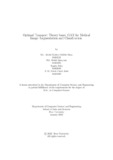Optimal transport theory based GAN for medical image augmentation and classification
Abstract
Unsupervised neural networks called Generative Adversarial Networks (GANs) are
used to provide realistic pictures without relying on the original data. Due to dis parities in illness occurrence, the challenge of class imbalance is prevalent in the
medical area, making the development of these applications tough. In order to solve
the issue of class imbalance, several GAN-based approaches have been presented.
However, since extracting significant information from just a few pixels is laborious,
these designs have not effectively trained for small-scale disorders. To address the
difficulty of insufficient quantities and imbalances of medical imaging data, data
augmentation methods such as image modifications have been utilized to minimize
performance degradation. Optimal Transport (OT) theory allows for the develop ment of a geometry for a space of functions, providing a definition of distance in
this space, a technique for interpolating between various functions, and, in a more
general sense, establishing the barycenter of a family of weighted functions. Con sequently, optimal transport is presented as a fundamental tool in many applied
domains. Measures with non-overlapping supports are well-suited to occupational
therapy. However, using OT to train generative machines raises challenges like (1) a
lack of smoothness, (2) the computational burden of evaluating OT losses, and (3)
the difficulty of estimating gradients in high dimensions. Because of this, Skinhorn
divergence will be utilized to create a loss family that includes both Wasserstein
(OT) and Maximum Mean Discrepancy (MMD) losses. It will help us identify a
sweet spot by utilizing OT’s geometry and generating high-dimensional spaces from
low-dimensional manifolds. Applications of the transport map for image augmenta tion and classification include computing geodesics between pictures and transferring
one image’s attributes to another. The nature of the seen items must be preserved
in this situation in order to create pictures that are both physically and aesthetically
convincing. Our proposed Optimal Transport Theory-based GAN model is able to
detect and differentiate between chest X-ray images with a high degree of accu racy. The proposed method of image augmentation was used for the classification
of normal, COVID-19-effected, lung opacity, and viral pneumonia images. In terms
of accuracy, precision, recall, and f1 score, which are all tested in this paper, our
proposed Optimal Transport Theory-based GAN model performs comparably on
the available datasets. The suggested model is accurate to 96.94%, which is greater
than any of the experimental results of CNN models utilized in this research due to
the fact that the recommended model was developed.

